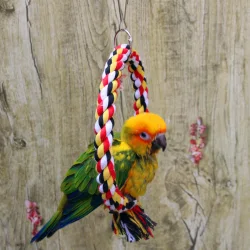Top 5 Types of Bird Toys Every Bird Owner Should Know About
2024-09-29
Bird toys come in all shapes and sizes, and finding the right ones for your feathered friend can be overwhelming. But selecting the right toys is crucial for keeping your bird entertained, engaged, and healthy. Here’s a guide to the top five types of bird toys every bird owner should know about and how they benefit your pet.
1. Foraging Toys
Foraging is a natural behavior for birds. In the wild, birds spend a large part of their day searching for food, but in a domestic setting, this behavior can be stifled. Foraging toys are designed to replicate this natural activity, challenging your bird’s mind and providing hours of entertainment.
- Why they’re important: These toys keep birds mentally engaged, preventing boredom and destructive behavior.
- Example: Food puzzles that require your bird to figure out how to extract seeds or treats hidden inside.
Foraging toys offer mental stimulation and encourage birds to use their problem-solving skills.
2. Chew Toys
Birds naturally love to chew, and chew toys are a great way to satisfy this instinct. Made from bird-safe materials like wood, leather, and natural fibers, these toys help birds maintain healthy beaks and prevent them from chewing on furniture or cage bars.
- Why they’re important: They provide an outlet for chewing behaviors while promoting beak health.
- Example: Wooden toys that your bird can gnaw on to keep their beak filed and trimmed.
Chew toys also provide a tactile experience, keeping birds entertained and engaged.
3. Swings and Perches
Birds love to perch, balance, and sway, and swings and perches offer the perfect opportunity for this. These toys allow birds to practice their balancing skills and encourage movement, helping them stay physically active.
- Why they’re important: They provide both exercise and entertainment, helping your bird stay fit and coordinated.
- Example: Swings that hang from the top of the cage, or multi-level perches that encourage climbing.
Swings and perches mimic the natural tree branches birds would use in the wild, providing both comfort and exercise.
4. Foot Toys
Foot toys are small, grabbable objects that birds can pick up and manipulate with their feet. These toys encourage dexterity and help birds build their motor skills. They also provide an excellent distraction for birds who might become bored or anxious.
- Why they’re important: They promote fine motor skills and keep birds entertained with minimal effort.
- Example: Small balls, rings, or wooden shapes that your bird can easily pick up and toss around.
Foot toys keep your bird busy and help reduce stress, especially in more active birds.
5. Interactive Toys
Interactive toys involve some kind of interaction, whether it’s a bell that rings when touched, a mirror that reflects, or a toy that makes noise. These toys provide both mental stimulation and a sense of companionship, especially for birds that may spend time alone.
- Why they’re important: They engage your bird in playful activities and can reduce feelings of loneliness.
- Example: Bell toys or mirrors that hang in the cage and respond when touched.
Interactive toys add variety to your bird’s day and help keep them emotionally stimulated.
### How to Choose the Right Toys for Your Bird
When choosing toys, it’s important to consider your bird’s size, species, and personality. Larger birds may need more durable toys, while smaller birds may prefer lighter, easier-to-handle objects. Additionally, some birds may be more interested in foraging or climbing, while others prefer interactive or chewable toys.
1. Rotate toys regularly: Birds can get bored easily, so switching out toys every week or two will keep things fresh and exciting.
2. Use bird-safe materials: Ensure that all toys are made from non-toxic, bird-friendly materials. Avoid toys with small parts that could pose a choking hazard.
Conclusion
Providing the right types of toys for your bird is essential to their physical and mental health. From stimulating their foraging instincts to giving them opportunities for physical exercise, the right toys can significantly enhance your bird’s quality of life. Whether you’re offering a new chew toy or a fun swing, keeping your bird entertained will lead to a happier and healthier pet.



